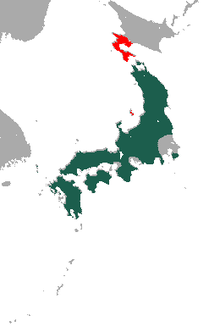Martes melampus
| Japanese marten | |
|---|---|
 |
|
| Scientific classification | |
| Kingdom: | Animalia |
| Phylum: | Chordata |
| Class: | Mammalia |
| Order: | Carnivora |
| Family: | Mustelidae |
| Genus: | Martes |
| Species: | M. melampus |
| Binomial name | |
|
Martes melampus (Wagner, 1841) |
|
 |
|
| Japanese marten range | |
The Japanese marten (Martes melampus) is a mammal in the marten genus most closely related to the sable. It is half a meter (1½ feet) in length on average, not counting a 20-centimeter-long tail (7.9 in), and between 1,000 and 1,500 grams (2.2 and 3.3 lb) in weight. Males are generally larger than females. The pelage varies in color from dark brown to dull yellow with a cream-colored throat.
Both males and females are territorial, the size of each individual's territory depending on food availability. The Japanese marten is omnivorous, preferring meat from fish, frogs, and small birds and mammals, but consuming insects, fruit, and seeds when necessary.
There are two confirmed subspecies of Japanese marten:
It has been recorded in the southern Korean Peninsula but there are no locality details to prove a wild origin and no native population has been confirmed.
Japanese martens have a breeding season which occurs between March and the middle of May. They usually produce one offspring; however, they can have anywhere between one and five kits per mating season. The offspring are born blind and deaf. As a mammal, the female produces milk for her young offspring, but by three to four months of age the kits are able to hunt and soon leave their mother. Sexual maturity occurs between one and two years. Average lifespan in the wild is unknown although a specimen in captivity live for a little more than twelve years.
After reaching maturity, young martens often try to establish their territory. They mark their territory with scent marking.
Japanese martens live in boreal forests in much of Japan's mainland. In the winter, martens tend to go to the forests where they can get the most prey. They tend to choose well-established forests because of the ways the creatures have specialized and due to their long life-span. As such, it has been suggested that martens are valuable in accessing the health of the forest. However, in the summer, their habitat and diet become much more generalized allowing them to live in a much more varied environment.
One of the biggest roles martens play in the environment is seed dispersal. Many fleshy fruits rely on birds and bats to disperse their seeds; however, in more northern climates the numbers of these species decrease. With the decrease of these species, there also comes a decrease in seed dispersal. In these areas, carnivores with omnivorous diets, like the Japanese marten, can become the vector of dispersal. These carnivores prove to be good dispersal mechanisms because they often have large home ranges leading to dispersal farther from the parent. Furthermore, since the carnivores are usually larger than birds or bats, the can carry and disperse larger seeds. A study in 2000 found that around 62% of the Japanese marten's feces contained one or more seeds.
...
Wikipedia

